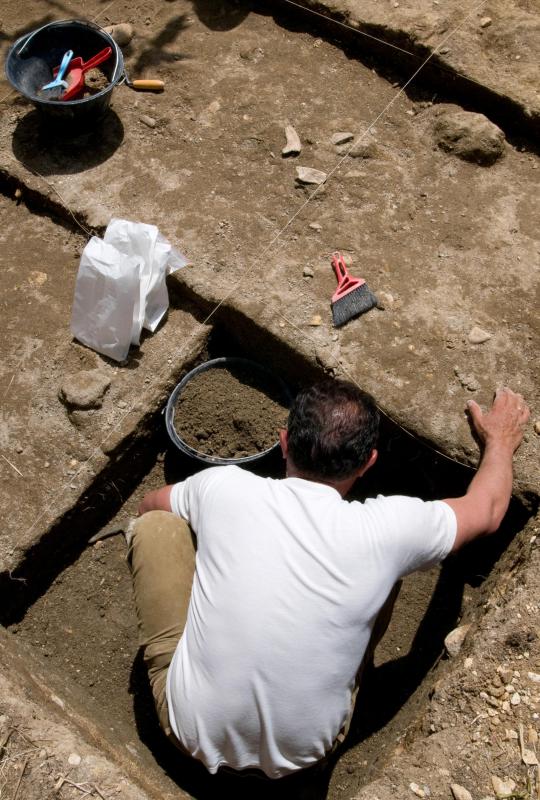At AllThingsNature, we're committed to delivering accurate, trustworthy information. Our expert-authored content is rigorously fact-checked and sourced from credible authorities. Discover how we uphold the highest standards in providing you with reliable knowledge.
What Is Pitchstone?
Pitchstone is an igneous rock with properties similar to that of obsidian and flint. Like obsidian, pitchstone is a naturally-occurring glass, formed from quickly cooled lava. It is somewhat darker and grainier than obsidian, making it similar in appearance to flint. All three of these stones also tend to flake and shear the same way, making them ideal for making arrowheads, spear points, and stone knife blades. Archaeologists have found weapons made of this stone in many Mesolithic-era digs, especially in areas suspected to have contained ancient volcanoes. Spiritualists may also use pitchstone in ways similar to obsidian and Apache tears because they believe it contains energetic properties that may help with certain emotional and spiritual conditions.
The formation of this stone most often occurs when lava makes contact with water or some other cooling force, like frozen ground. This molten rock solidifies too quickly to form crystals, meaning it contains no lattice structure. Instead, it is smooth like glass. Many samples of pitchstone are mottled, especially when held up to the light. Observers may see areas of opaque feldspar intermingled with smooth, glassy, transparent areas. The opaque areas often dissipate into speckles that run throughout the pieces of rock.

Archaeological finds often uncover a combination of pitchstone and flint weapons and tools. This combination is especially prevalent in Arran, an island off the coast of modern-day Scotland. A Mesolithic-era dig site there revealed that settlers in the area were able to quarry both of these stones. There seems to be no preference toward one or the other, as the settlers seem to have used both stones equally. Both stones are also very sharp and relatively strong when shaped into knives and weapon points.

Obsidian and pitchstone weapons are also often found side-by-side. Both stones form when lava cools quickly, meaning they would be easily retrieved from some of the same quarry sites. The content of the lava usually determines what kind of stone it forms when it becomes solid. Heavy feldspar deposits usually result in pitchstone, while less feldspar results in the formation of obsidian.

Many spiritualists also use these igneous stones interchangeably. Though obsidian and Apache tears are usually more readily available, pitchstone is often seen as an acceptable substitute for either. Actually, apache tears are very clear, highly polished pieces of obsidian. All of these igneous stones are said to help assuage grief and depression, and help ward off bodily diseases. They’re also supposed to help the wearer block and shed negative energy.
Frequently Asked Questions
What is pitchstone and how does it form?
Pitchstone is a volcanic glass similar to obsidian but with a more resinous, pitch-like luster. It forms when felsic lava cools rapidly, preventing crystal growth. The presence of water during cooling contributes to its distinctive texture. Unlike obsidian's smooth surface, pitchstone's high water content gives it a more matte finish and a slightly less brittle composition.
Where can pitchstone be found?
Pitchstone is less common than other volcanic glasses and is typically found in areas with past volcanic activity. Notable locations include the Isle of Arran in Scotland and the Yellowstone Caldera in the United States. Its occurrence is often linked to the final stages of a volcanic eruption, where the lava flow cools quickly in a water-rich environment.
What are the uses of pitchstone?
Historically, pitchstone was used by indigenous peoples for making tools and weapons due to its sharp edges when fractured. Today, its unique appearance makes it a sought-after material for decorative items and jewelry. However, its relative rarity compared to obsidian means it is less commonly used in modern industry.
How does pitchstone differ from obsidian?
Pitchstone and obsidian are both forms of volcanic glass, but pitchstone has a duller, more resinous sheen due to its higher water content. This water content also makes pitchstone less glassy and more prone to a rough texture. Obsidian is typically harder and more brittle, with a conchoidal fracture that creates sharper edges.
Can pitchstone be used to date volcanic eruptions?
Yes, pitchstone, like other volcanic glasses, can be used in dating volcanic eruptions through a process called hydration dating. This technique measures the water layer absorbed on the glass surface, which grows over time. By determining the hydration rate, scientists can estimate the age of the pitchstone and thus the associated volcanic event.
Is pitchstone dangerous to handle?
Pitchstone is not inherently dangerous to handle, but caution should be exercised due to its sharp edges when fractured. It can cause cuts similar to handling glass. Wearing protective gloves is recommended when working with pitchstone in a raw form, especially during cutting or shaping for tool-making or artistic purposes.
AS FEATURED ON:
AS FEATURED ON:













Discuss this Article
Post your comments